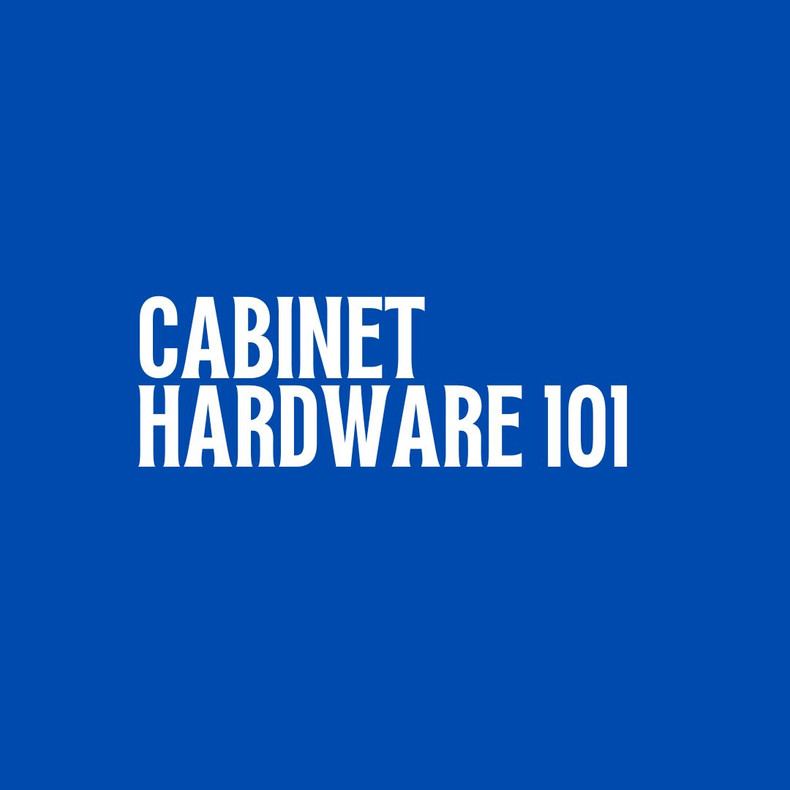Welcome to Cabinet Hardware 101 – your go-to guide for all things cabinet hardware.
Over the next few weeks, we will be going over everything you need to know about selecting the perfect hardware for your space. From technical terms to budgeting tips to style choices and how to avoid common mistakes, Cabinet Hardware 101 is here to help you make confident, functional, and stylish decisions. This week we are going to cover common mistakes.
Hinge Basics: What You Need to Know Before You Buy
When it comes to cabinet hardware, hinges are the unsung heroes. They may not be as flashy as knobs or pulls, but they’re essential for how your cabinets function—and how long they last. Whether you're building new cabinets or replacing existing hardware, understanding the basics of hinges will help you make smarter, smoother decisions.
What Is a Cabinet Hinge?
A cabinet hinge connects the cabinet door to the frame (or box) and allows the door to open and close. But not all hinges are created equal. They come in a variety of styles, materials, and configurations based on how your cabinet is constructed and how you want the door to function.
1. Identify the Hinge You Already Have
Before you shop for new hinges, take a close look at the ones already installed. Replacing them with the same type can simplify installation and ensure proper alignment. Here's how to identify them:
A. Is it visible or hidden?
- If you can see the hinge when the door is closed, it's exposed.
- If it's only visible when the door is open, it's a concealed (European-style) hinge.
B. Check how the door sits on the cabinet
- If the door overlaps the frame or box: Overlay hinge
- If the door sits flush inside the cabinet frame: Inset hinge
- If two doors share a single divider and only partially cover it: Half overlay
C. Look for special features
- Soft-close? Try slowly closing the door—if it glides shut on its own, you likely have soft-close hinges.
- Self-close? If the door snaps shut with a slight push, it’s probably self-closing.
D. Take measurements
- Measure the cup diameter (the circular part installed in the door) and the distance between screw holes. These measurements are critical if you're replacing concealed hinges.
E. Check the cabinet type
- Look at the cabinet structure. Face frame cabinets have a frame around the front. Frameless (European-style) cabinets do not.
A quick photo and a few measurements can also be useful if you're asking for help at a hardware store or online forum. We also recommend bringing in the hinge and the door to the store so we can best help.
2. Face Frame vs. Frameless Cabinets
Before you choose a hinge, you need to know what kind of cabinets you have:
- Face Frame Cabinets have a frame around the front edge. Hinges attach to the frame.
- Frameless Cabinets (European-style) have no front frame; hinges attach directly to the cabinet box.
3. Hinge Mounting Types
- Overlay Hinges: Door covers the cabinet box or frame.
- Inset Hinges: Door sits flush inside the cabinet.
- Half Overlay Hinges: Two doors share a divider, each covering part of it.
4. Hinge Styles and Features
- Concealed Hinges: Hidden when the door is closed.
- Exposed Hinges: Visible on the outside, often decorative.
- Soft-Close Hinges: Contain a damper to prevent slamming.
- Self-Closing Hinges: Pull the door shut when lightly pushed.
5. Opening Angles
- Common options include 110°, 125°, and 165°
- Wider angles provide better access, but may hit nearby walls or appliances.
6. Screw-On vs. Clip-On Hinges
- Screw-On: More permanent, but harder to remove or adjust.
- Clip-On: Easy to install, remove, and adjust—great for DIYers.
7. Material & Finish Options
- Hinges are typically steel, brass, or zinc alloy
- Common finishes: nickel, chrome, black, oil-rubbed bronze
Quick Buying Tips:
- Identify what you have before buying replacements.
- Match hinge type to cabinet construction.
- Consider soft-close or self-close for added convenience.
- Measure carefully—especially cup diameter and screw spacing.
- Choose quality over price for long-lasting function.
Hinges might be out of sight, but they shouldn’t be out of mind. Choosing the right hinge makes your cabinets look better, function better, and last longer. By understanding how to identify what you already have, you’re in a great position to upgrade or replace your cabinet hinges with confidence.


